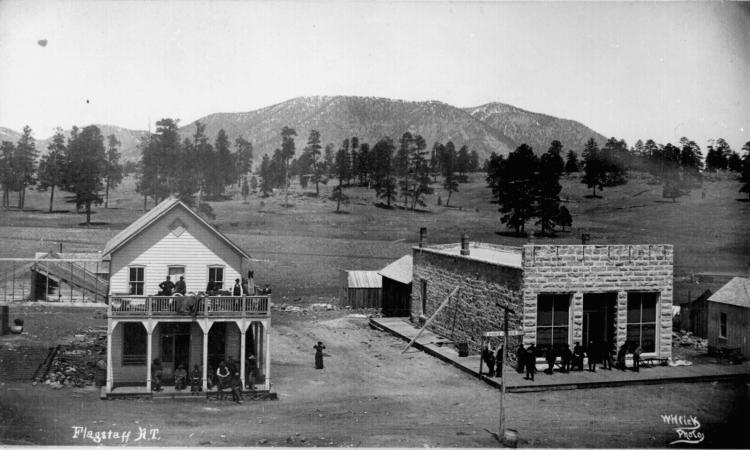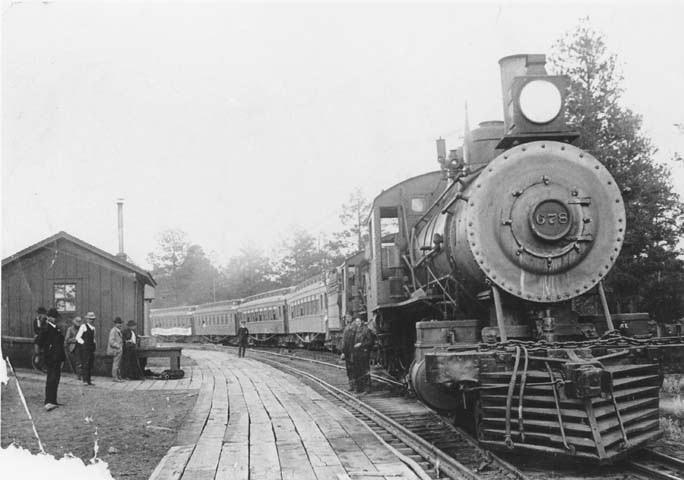Request A Free Travel Guide
The Flagstaff Travel Guide is an annual publication featuring the accommodations, restaurants, activities and useful travel information for the Flagstaff area.
Get The GuideNestled at 7,000 feet near the base of the San Francisco Peaks, Flagstaff reigns as the mountain jewel in the crown of the desert state of Arizona.

It beckons with its clear air, cool pine forests, and proximity to historic and natural attractions. Flagstaff is a region settled by varied cultures and built by strong men and women pioneers that made this city what it is today.
Soon after Arizona became American territory from Mexico in 1848, the U.S. Congress began to explore the Nation’s new territories, sending out various parties to find resources, make maps and locate paths. Between 1857 and 1860, Lt. Edward Beale was sent to build a road across northern Arizona. He sent glowing reports to Congress, telling them how the Flagstaff area was rich in grasslands, water and timber. Once the Beale Road was established it became well traveled by emigrants going to California. The travelers noted Flagstaff’s resources as a treasure chest, but its isolation meant no nearby markets for farm products, meat or lumber and no way to ship goods to distant markets. One such party of emigrants came from Boston in 1876. Originally planning to settle in the Little Colorado River area near Winslow, they found the area already settled and decided to move on to California. On July 4, 1876, the group camped at a small spring with the peaks looming overhead. In honor of the nation’s centennial, they stripped a pine tree of its branches and bark and raised an American flag. When they moved on, their “flag staff” became a landmark for those who followed. That same year, a small group of sheep ranchers moved to the area and set up their ranches where they found grass and water. The isolation of the area was not a problem to them because wool did not spoil and could withstand the long, rough journey to market in Boston.
The days of isolation ended for the Flagstaff area when in 1880, the Atlantic and Pacific Railroad began to lay track westward from Albuquerque on its way to California. Entrepreneurs quickly found they could capitalize on the railroad’s construction crews by selling food, supplies and entertainment from the supply camps they set up along the line. As the rails neared the San Francisco Peaks, a small settlement began to take shape by a small spring on the slope of what is now called Observatory Mesa (or Mars Hill), just west of today’s downtown Flagstaff. In early 1881, merchants and saloonkeepers set up shop for the advance parties of workers who were coming to grade and cut ties in the abundant ponderosa forest. That same year the citizens of the little camp called their new town Flagstaff, in honor of the landmark. By the fall of that year, Flagstaff boasted a population of 200 and swiftly became a wild railroad town filled with saloons, dance halls and gambling houses. On August 1, 1882, the railroad finally reached Flagstaff. As the construction crews moved westward to California, some of Flagstaff’s citizens followed after them, but others stayed, hoping that the camp could continue to thrive. Fortunately for those who stayed, Flagstaff became an established stop for water servicing the railroad and its passengers. Sheep ranchers began to use the railroad to transport wool and cattle ranchers, drawn by the prospect of free or inexpensive land, realized that they could now affordably ship their beef to the eastern market. Businessmen such as E. E. Ayers, set up Flagstaff’s largest lumber mill before the railroad got to town, and began shipping lumber within days after the rails arrived. By winter 1882, Flagstaff was a firmly established town with a railroad, livestock and lumber industries and a service industry of merchants, cafes, hotels and saloons to serve the sheepherders, cowboys, lumberjacks and train travelers.

In 1883, the railroad decided to move their depot about a half mile east of the Flagstaff settlement so their trains didn’t have to start up on the steep hillside. One of the local merchants, P.J. Brannen, saw this as an opportunity and decided to move his mercantile across from the depot. Others followed, building a strip of shops, saloons and hotels along what became known as Front Street. As a result, Flagstaff became two settlements: the original site called Old Town, and the site near the depot named New Town. Old Town had water, but New Town had commerce and soon outgrew the older settlement. In 1884, a devastating fire burned down many of Old Town’s buildings and New Town became the one and only Flagstaff. Its center was the intersection of Front and San Francisco Streets. Later Front Street would be called Railroad Avenue, but in 1926, the road became part of Route 66 and was renamed Santa Fe Avenue. In 1993, the road was renamed for the historic Route 66, and it continues to be a major thoroughfare of the city. By the early 1890’s, the young town of Flagstaff had reached a population of 1,500 and had become one of the largest towns in the territory. It had a well developed business district and homes were being built throughout the area. The inhabitants realized that the town would soon be too big to continue without some kind of formal organization.
In 1891, with newfound status and at the urging of prominent local citizens, Coconino County was split off from Yavapai County. Flagstaff became the new county seat. Unfortunately, concerns such as the regulation of drinking and gambling and most importantly–the need for water–were not being addressed. In Flagstaff’s early days water was provided from Old Town spring and other small area springs but with no water nearby, several large fires, like the 1884 fire that burned Old Town, took a hefty toll. A logical solution was to tap the springs in the San Francisco Peaks, but the cost and logistics were not feasible. Town leaders talked about the need to incorporate Flagstaff not only to gain the status it needed to have an effective local government, but also to allow for the sale of municipal bonds to pay for the water project. In 1894, a petition was circulated among the citizens and on May 26, 1894, by action of the Coconino County Board of Supervisors, Flagstaff became an incorporated town. In the ensuing century since that incorporation, Flagstaff continued to thrive and the lumber, cattle and sheep industries grew. The formation of a Normal School, which later would become Northern Arizona University was to follow, as was the establishment of a world-class private observatory and the birth of a vast National Forest. Perhaps the most important development for Flagstaff was its growth as a strong tourism based center. Hundreds of thousands of people now visit Flagstaff every year. They come to hike and camp in the pristine wilderness of the largest ponderosa pine forest in the world, visit our National Monuments and museums, the Grand Canyon and other local attractions. From it’s humblest beginnings, Flagstaff’s natural beauty has been the reason people come to visit, and the friendly attitude of the people they find here is the reason they return again and again.